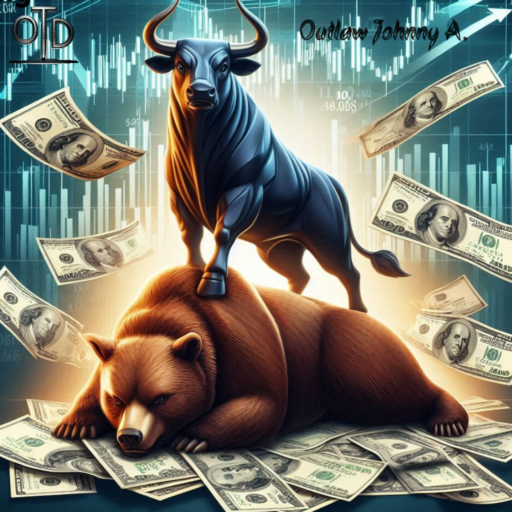A Week of Woes and Winks
The S&P 500, the barometer for the broader market, was down about 1.5% for the week—a decline that might have prompted investors to question if they’d accidentally left their calculators at home. Meanwhile, the NASDAQ Composite wasn’t far behind, slipping roughly 2.7% as tech giants got their lofty valuations knocked off their pedestals. It was a week where even the “tech titans” couldn’t outsmart the harsh realities of rising costs and dwindling consumer cheer.
Tariff Turmoil and Inflation Antics
At the heart of the carnage was President Trump’s renewed tariff rhetoric—yes, the same policies that have become as predictable as a soap opera cliffhanger. His aggressive tariff announcements on auto imports and other goods not only rattled investor nerves but also added to already simmering inflation worries. The market’s reaction? A 2% drop on Friday alone, with the S&P 500 shedding 112 points and the NASDAQ Composite plunging 2.7% as traders scrambled for safe havens. (Told you smart money was moving to bonds 2 months ago) Meanwhile, inflation data—hotter than your morning coffee—fueled fears that the Federal Reserve might be forced to play whack-a-mole with interest rates, just when consumers were already tightening their purse strings. The result was a cascading selloff that, while ostensibly meant to signal caution, left investors with little choice but to mutter about “stagflation” in hushed tones.
Consumer Sentiment: The Ultimate Party Pooper
If there were a way to gauge just how ‘tired’ American shoppers are, consumer sentiment would be the prime example. Surveys from the University of Michigan painted a bleak picture—worrying enough to prompt economists to predict that if consumers keep spending less (as they indeed have), corporate earnings might soon be as stale as last week’s bread. It appears that when the average U.S. consumer feels as gloomy as a rainy Monday, even the most promising tech stocks can’t lift the mood.
Cross-Referencing the Carnage
The week’s downturn was not merely a case of isolated jitters but a coordinated symphony of economic concerns. Whether it was the dramatic 715-point plunge in the Dow or the sharp declines across European and Asian markets triggered by similar tariff fears, the consensus is clear: uncertainty reigned supreme.
Monday-Tuesday: The Momentary Mirage of Hope
Remember when your ex promised they’d changed? That’s essentially what the market did to investors on Monday. After weeks of tariff-induced trauma, the S&P 500 surged a remarkable 1.76% while the NASDAQ Composite soared 2.27% on hopes that the Trump administration might take a “more measured approach on tariffs.” How adorably naive we all were.
Tesla, the poster child of market volatility, jumped nearly 12% in its biggest one-day gain since November. Meanwhile, the Dow Jones Industrial Average rose 1.42% to 42,583.32 points. This fool’s rally continued with modest gains on Tuesday, with the S&P 500 adding a measly 0.16% to close at 5,776.65, while the NASDAQ Composite gained 0.46% and ended at 18,271.86.
Investors were content to ignore Tuesday’s dismal March consumer confidence data, which reflected “a significant drop in U.S. consumers’ near-term outlook on income, business, and job conditions.” After all, why let pesky economic fundamentals ruin a perfectly good delusion?
Wednesday-Thursday: Reality Bites Back
Wednesday offered a deceptive breather as markets digested conflicting signals. On one hand, Trump confirmed his intention to implement auto tariffs; on the other, strategists like Piper Sandler’s Craig Johnson optimistically suggested “an intermediate-term low may be in place despite the heightened uncertainties surrounding tariffs and inflation.”
But Thursday took a particularly sadistic pleasure in reminding investors that hope is a dangerous thing. Markets dived after Trump announced on his Truth Social platform that he would impose a “200% tariff on imports of European wines and spirits” in retaliation for the EU’s 50% tax on American whiskey exports. Nothing says “stable economic policy” quite like announcing major tariffs via social media.
Friday: The Grand Finale of Failure
Friday’s trading session was the rotten cherry on top of this melting market sundae. Investors received a one-two punch of dreadful news: a hotter-than-expected PCE inflation reading and dismal consumer sentiment data. The result? The S&P 500 tumbled 1.97% to end at 5,580.94, while the NASDAQ Composite plunged 2.70% to close at 17,322.99. The Dow wasn’t spared either, shedding 715.80 points or 1.69%.
Tech giants, who had briefly led Monday’s rally, now led the spectacular retreat. Google parent Alphabet lost 4.9%, while Meta and Amazon each shed 4.3%. It’s almost as if these companies might be affected by global trade disruptions! Who could have possibly foreseen this?
The Weekly Tally: Another Brutal Week for the History Books
For the week, the S&P 500 lost 1.53%, while the Dow shed 0.96%. The NASDAQ declined by 2.59%. The Russell 2000 small-cap index fell 2.05% on Friday alone, closing at 2,023.27, contributing to a significant weekly decline.
Even more alarming, the NASDAQ is now on pace for more than an 8% monthly decline, which would mark its worst monthly performance since December 2022. Meanwhile, the small-cap Russell 2000 is edging closer to bear market territory, a drawdown of 20% from its high.
Why the Market’s Down (As If You Didn’t Know)
The week’s volatility largely stemmed from three key factors:
- Tariff Uncertainty: Trump’s chaotic rollout of tariffs continued to bewilder investors. Wednesday’s announcement of 25% tariffs on imported automobiles, followed by Thursday’s threat of 200% tariffs on European spirits, kept markets in a perpetual state of anxiety.
- Inflation Concerns: Friday’s PCE data showed that core PCE inflation rose 2.8% year over year in February, exceeding economists’ forecasts. This reinforced fears that inflation might be more stubborn than previously thought, potentially delaying Fed rate cuts.
- Consumer Sentiment Collapse: The University of Michigan’s consumer sentiment survey for March showed sentiment “plummeted to its lowest level since November 2022” as consumers fretted about inflation and labor market conditions. Nothing boosts market confidence quite like knowing consumers are terrified.
Looking Ahead: April 2nd and Beyond
So what’s next? Wall Street strategists, in their eternal optimism (or delusion), suggest that markets might stage a dramatic recovery after April 2nd, when Trump’s full tariff plans are expected to be revealed. As Fundstrat’s Tom Lee noted, “We’ve already sequenced a lot of the panic that people saw in 2018. As much as I appreciate Tom Lee’s sparkling insights—truly, his opinions are as delightful as a warm pastry—I have to call foul in the short term. Sure, he’s right that tariff chatter is already baked into the market cake, and a rally might be on the horizon. But don’t be fooled: I’m convinced it will be nothing more than a bear trap rally, set to snare the unwary. While a pile of cash sits idly on the sidelines ready to fuel this fleeting surge, the “smart money” has already scooted off to bonds or ventured into the comparatively serene pastures of Europe and China. Meanwhile, supply chains and corporate strategies are moving at a glacial pace, making it almost inevitable that next-quarter guidance will take a nosedive. In my view, cash is king—earning interest while the rest of us chase shadows—and this market hasn’t even found its bottom yet in 2025.
“Remember, as Wall Street veterans like to say, the market can remain irrational longer than you can remain solvent. This week was just another master class in that timeless wisdom.
Summary: TLDR
Listen, darlings— I’ve seen this movie before, and the ending isn’t pretty. Yes, the market is currently oversold, like last season’s fashion line, and we’re all staring at charts that look like the aftermath of a financial hurricane. The technical indicators are flashing “BARGAIN!” in neon lights, practically begging you to open your wallet.
But let’s be clear: the post-tariff rally that everyone and their uncle is anticipating? It’s nothing but a bear trap wearing a bull costume.
Sure, if you’re one of those adrenaline-junkie day traders who get a thrill from “renting” stocks for 48-hour roller coaster rides, be my guest. There’s probably money to be made for those with lightning-fast trigger fingers and an iron stomach. Just don’t come crying when your position turns against you faster than a politician after Election Day.
For the rest of us, cash remains the undisputed heavyweight champion right now. It’s earning a respectable yield while sitting safely on the sidelines, watching the volatility circus from a comfortable distance.
I remain firmly convinced that this market has not yet found its true bottom for 2025. We’re still in the “denial” phase where everyone’s searching for the magic catalyst that will reignite the bull run. Financial advisors are still answering their phones—so I guess the bottom has yet to arrive.
Some truly spectacular bargains await around that corner we can’t quite see yet. The patient investor who preserves capital now will be positioned to feast when genuine fear finally grips the market.
Remember Warren Buffett’s immortal advice: “Be fearful when others are greedy and greedy when others are fearful.” Right now, there’s still too much hope masquerading as fear. When that hope finally evaporates, that’s when I’ll be reaching for my buying list.
Until then? I’ll be the one earning interest while others chase phantoms.

